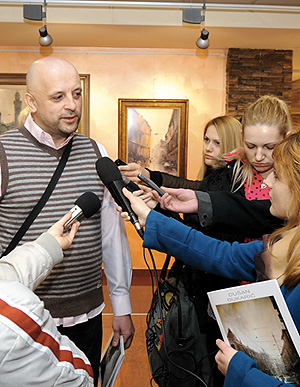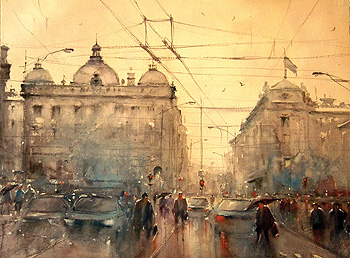Eye
DUŠAN ĐUKARIĆ, ONE OF THE MOST AUTHENTIC SERBIAN WATERCOLOR PAINTERS TODAY
Uniting and Overgrowing
He elevated this form of art to a higher level. We do not recognize his urban centers by the accuracy of their description, but by the impression they leave. He is a painter of atmosphere, not one who copies reality. By uniting the European and Far East style, mimesis and abstraction, sensuality and intuition, fond of before all life, he introduces calmness and feeling for space into his works. Still life, oriental scenes, marinas, landscapes, nudes, streets... Especially attractive are his scenes of Belgrade and Venice
By: Dejan Đorić
 Although suppressed from galleries and not present in art schools as a painting technique, watercolor was extraordinarily successful in Serbian art in the late XX and early XXI century. Both avant-garde and traditional artists create in this art technique, according to some the most difficult one. Special schools arrived, important watercolor painters and their followers. Although suppressed from galleries and not present in art schools as a painting technique, watercolor was extraordinarily successful in Serbian art in the late XX and early XXI century. Both avant-garde and traditional artists create in this art technique, according to some the most difficult one. Special schools arrived, important watercolor painters and their followers.
In the past, watercolor, as well as drawing, was more of an auxiliary device in our art than an attention drawing art discipline. Today it is one of the supreme expressions of mainly figural art in Serbia, an independent discipline which has its devotees, collectors, even specialized galleries.
Ranko Beljinac, considered the best Serbian watercolor painter among the public and art milieu, was awarded with, among others, first prizes at large international exhibitions in England, where it is more difficult to win them. Since Beljinac departed, perhaps the most authentic Serbian watercolor painter is Dušan Đukarić. There are serious arguments supporting this thesis. They were given by some strict and critically oriented artists such as Vladan Radovanović.
ATMOSPHERE HUNTER
 Beljinac treated watercolor in a painter’s manner, as a technique with big possibilities of multilayered coloring, undercoloring, placing layers of color underneath, similar to the so-called ”dry brush”. That is why he painted his watercolors for a long time, meticulously, thoroughly, excluding the possibility of mistake, like in graphics, and accident, which is so important in watercolor painting. Beljinac treated watercolor in a painter’s manner, as a technique with big possibilities of multilayered coloring, undercoloring, placing layers of color underneath, similar to the so-called ”dry brush”. That is why he painted his watercolors for a long time, meticulously, thoroughly, excluding the possibility of mistake, like in graphics, and accident, which is so important in watercolor painting.
Đukarić started another path within the same problem. His style is in no way abstract or orientalistically free, he does not use the wide, superficial coloring of the surface, he is not familiar with leaking, dropping, splashing and chance elevated to artistic significance. This master’s manner of painting cannot be considered close to the Far East tradition, which had a big influence on modern art (enabling many works of Taschisme and Abstract Expressionism, forming painters such as Jackson Pollock, Mark Rothko and Zao Wou Ki).
Đukarić does not paint abstractly, but also does not reject some solutions of this school,   completely opposite from the European watercolor tradition in the spirit of meticulously processed details. He does not paint close to the aesthetics indicated by Albrecht Durer, for whom some supreme watercolor painters claim that European watercolor painting begins and ends with him. The Durer-like precise style was influential until the XIX century and Alexander Cozens, who suggested and realized painting landscapes using stains and spots. Dušan Đukarić works in the spirit of this teaching from the beginning of modern art. He liberated watercolor painting from the ultimate verism, he is not interested in making his work only a mimetically true reflection of reality in the manner of (hyper)realism, but wishes to emphasize some features characteristic only for this art, to thereby separate and elevate it. That is why we notice the atmosphere, sfumato mists, evaporations, water steams, rains or smog in his watercolor paintings, and these effects are incomparably more difficult to present than faithfully, patiently and consistently copying sights from reality. completely opposite from the European watercolor tradition in the spirit of meticulously processed details. He does not paint close to the aesthetics indicated by Albrecht Durer, for whom some supreme watercolor painters claim that European watercolor painting begins and ends with him. The Durer-like precise style was influential until the XIX century and Alexander Cozens, who suggested and realized painting landscapes using stains and spots. Dušan Đukarić works in the spirit of this teaching from the beginning of modern art. He liberated watercolor painting from the ultimate verism, he is not interested in making his work only a mimetically true reflection of reality in the manner of (hyper)realism, but wishes to emphasize some features characteristic only for this art, to thereby separate and elevate it. That is why we notice the atmosphere, sfumato mists, evaporations, water steams, rains or smog in his watercolor paintings, and these effects are incomparably more difficult to present than faithfully, patiently and consistently copying sights from reality.
THE POWER OF SHADES AND DETAILS
Đukarić elevated watercolor painting to a higher level. We do not recognize his urban centers by the accuracy of description, but by the impression they leave. He is a painter of atmosphere, not one who consistently copies reality. By uniting the European and Far East style, mimesis and abstraction, sensuality and intuition, fond of before all life, he introduces calmness and feeling for space into his works.
 
He was noticed already at his first one-man exhibitions in Belgrade. The collectors purchased all the exhibited works. Soon he brought his technique to virtuousness, unlike many in contemporary figural watercolor painting, and painted one hundred sixty centimeters formats. Experts say that his manner of work corresponds to the true nature of watercolor painting more than Beljinac’s. Besides flattering attributes, Đukarić is connected to Beljinac with an unusual fact. Beljinac was a highly esteemed icon painter who stopped painting icons after becoming a watercolor painter. Dušan Đukarić similarly replaced his career of a successful fresco painter to become a watercolor artist. In the relations between icons and frescoes, miniature and monumental paintings, preciseness and abstractness, meticulousness and simplicity, probably lies the secret of this master’s skill.
***
Path, Work
Born in 1971 in Teslić, Bosnia, studied in Belgrade, where he lives and works today. He painted a number of churches, several iconostases and many icons. In watercolor painting, he is famous for dominating the atmosphere of the painting with ease. Still life, oriental scenes, marines, landscapes, nudes, streets… He experimented with many subjects. Especially attractive are his scenes of Belgrade and Venice.
He had a number of independent and group exhibitions. We will only mention the one in ”Progres” Gallery (2005) and the one in the Museum of Ethnography (2006), both in Belgrade.
Winner of many awards.
***
Joyful Enthusiasm
”Beginning with the ’accidental caprices of an unconscious hand’, and led by the enthusiasm of the freedom of gesture, in his watercolor paintings Dušan Đukarić reaches fluid emanations which shine towards our heart. If watercolor painting is an intimate conversation between the soul, whiteness of the paper and fluid stains of color, then I see the charm of Đukarić’s watercolor paintings mainly in the border between something wavy and hardly touched, in the freshness and intangibility of the white spaces… Đukarić painted his watercolor paintings with reserved sensuality not only by using color, but also by giving spirit to the psychological white spaces on the paper. With light and tone gradation he decomposes, makes layers and gives rhythm to sights that intrigue him, thus opening a special experience of joyful enthusiasm to an observer with a sensitive structure of the soul.” (Dragan Jovanović Danilov)
|
